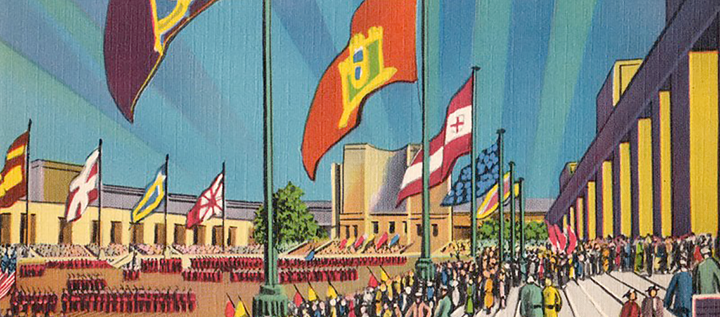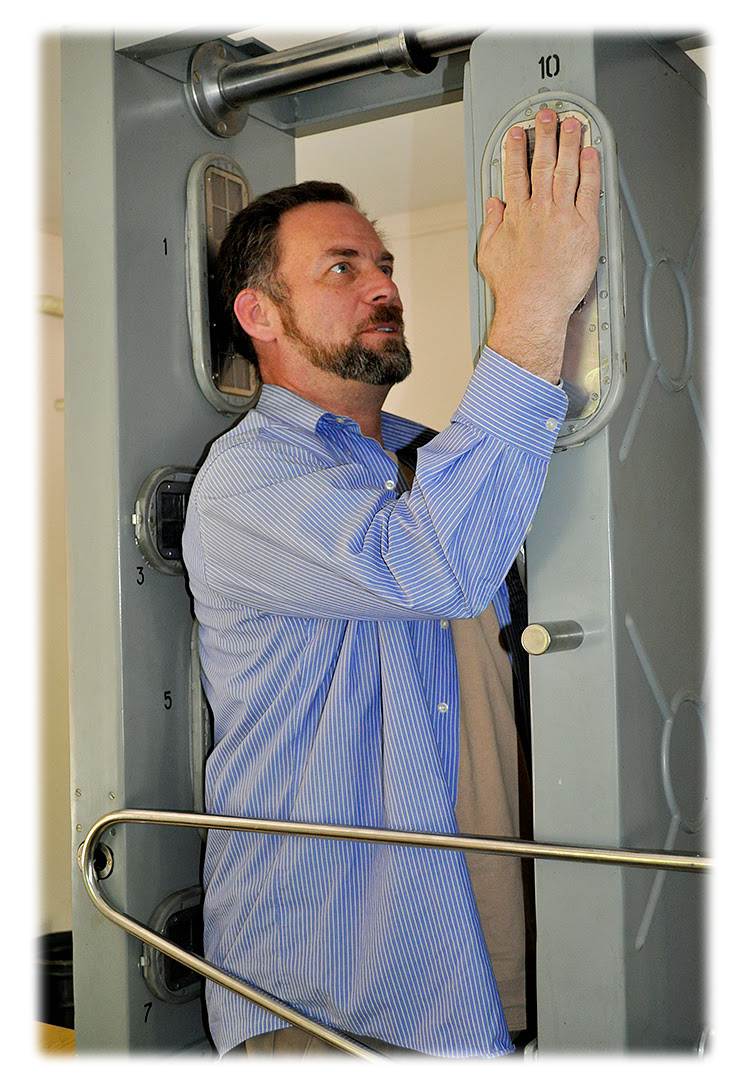Summary of Michel Foucault's "Of other spaces"
Foucault, M. (2008). Of other spaces (L. De Cauter & M. Dehaene, Trans.). In M. Dehaene & L. De Cauter (Eds.), Heterotopia and the city: Public space in a postcivil society (pp. 13-29). Milton Park, Abingdon, Oxon: Routledge.
Michel Foucault's musings on heterotopia are notoriously dense and
difficult to read. Some scholars go further in their critique, claiming
that he never intended his words on this topic to be published as a
formal essay; others even propose that he delivered this idea as a sort
of practical joke. Nonetheless, his formulation has inspired
generations of scholars to descend the rabbit hole of heterotopian
thinking. The version of Foucault's essay I've selected for this class
starts with translators' notes that unpack some of the work's
complexity. Thereafter, Foucault launches into a description of how the
nineteenth century focus on time has given way to a more recent
attention to space.
The author begins by explaining that our understanding of space -
particularly in the relationships between environments, peoples, and
things - has changed. He describes the arrangement medieval spaces as
one of hierarchy, with some spaces being more important than others. He
then notes how Galileo's heliocentric model challenged that sense of
hierarchy by suggesting that the vastness of space removes the
"localized" importance of any particular locale, even the Earth. From
this point, Foucault argues that a new perspective of space has arisen
in the modern era: emplacement.
The translators use that word, "emplacement," for several reasons. But
for our purposes, we might simply understand it as a "site" produced
through human sense-making.
The production of a site, after all, occurs amid an infinite array of
possible choices. Pause here and consider the rhetorical implication of
that move. What Foucault is saying is that an emplacement is not
created by some supreme force; it is a choice - like all rhetorical
forms - to organize the world and its human technologies, and to make
that organization seem reasonable, even necessary. Initially he adds
that our choices to array spaces in particular ways inspire all sorts
of technical challenges. More importantly, though, Foucault states that
the production of space (eg., a "classroom" amid a seemingly endless
array of roads and buildings) is "haunted by fantasy" (p. 16); it is
the choice of its inhabitants to adapt themselves to a shared meaning.
In other words, our performances of emplacement are just as necessary
as the designs and plans of its architects.
From that background, Foucault asks: What sorts of spaces should we
study, and how may we best understand them? He answers this question by
opting to focus on emplacements "that have the curious property of
being in relation with all the other sites, but in such a way as to
suspend, neutralize, or invert the set of relations designated,
mirrored, or reflected by them" (pp. 16-17). That... is a complicated
idea. I recommend that you read it a couple times; really think about
those words. What does he mean?
Well, Foucault offers two broad examples. First, he discusses utopias, which he defines as unreal spaces like Plato's Republic or More's island
that reveal the limitations of human relationships that we call real. A
utopia is a reflection of the world that showcases not what is but rather what should be.
Foucault then turns his attention to the actual focus of this essay:
heterotopias. These are spaces that exist - they do not reside solely
in the imagination - even though they reveal possibilities not found in
the world of everyday life. In the pages that follow, Foucault explains
heterotopias by summarizing a set of principles that guide their
emplacement.
Principle 1: All cultures produce heterotopias. There are two types:
Principle
1a: The primitive heterotopia may be termed a "heterotopia of crisis."
That word, "crisis," may seem like an odd choice, particularly when you
consider Foucault's examples: puberty huts,
boarding schools, and the like. Considering the roots of the word,
though, we may understand "crisis" as a "turning point" - such as the
one that occurs at puberty. To Foucault's way of thinking, the
heterotopian emplacement allows for that "crisis" to be managed safely
away from the regular pattens of public life. Why? Because the "crisis"
of puberty, for example, its blurring of childhood innocence and adult
maturity, could challenge the order of everyday public life, unless it
is set apart and managed.
Principle 1b:
The modern heterotopia may be termed a "heterotopia of deviation." The
production of this emplacement is necessary, Foucault claims, in a
society too vast and complex to manage social disorder in an organic
way. Think of a small town where most folks know each other. One person
may break the local rules. The collective response is not to build a
prison but instead to resolve the perceived problem in less formal
ways, either to tolerate that person's eccentricities, to request (or
coerce) adjustments in that person's behavior, or to banish (or
destroy) that person altogether. Modern society, in contrast, struggles
to accommodate rule-breaking. It must produce emplacements where
deviation may be managed. Thus we observe the design of psychiatric
hospitals and prisons, but we also imagine all sorts of other
emplacements of deviation that are not "prisons" in a technical sense
but are simply crafted to localize "other" behavior. Think of an
amusement park, where people pay to act in manners contrary to their
routine. Disneyland is hardly a prison (though you may disagree); yet
it is certainly a place set apart that works to manage and release the
tensions of public life.
 The Parish of Saint Cuthbert, Edinburgh, Scotland [Photograph by Andrew Wood]
The Parish of Saint Cuthbert, Edinburgh, Scotland [Photograph by Andrew Wood]
Principle 2: The functions of heterotopia change over time. To
illustrate this idea, Foucault describes the changing emplacement of
the cemetery. Prior to the eighteenth century, the bodies of the dead
were generally located at or near the center of public life, serving to
reflect a hierarchy of their relative importance. Notable people would
have their names etched in stone, to be memorialized in a central place
for as long as the structure lasted. Less notable people might be
commemorated in less durable ways and less central places, while
members of more modest economy would likely receive no marker and would
soon be forgotten altogether. In contrast, Foucault notes a modern
democratization of the dead, where all people expect their mortal
remains to be saved. This would appear to be an ironic choice, given
the increasingly atheistic character of public life. But Foucault
explains that the population and movement of cemeteries from the center
to the margins of our cities reflects an anxious attitude
that modern folks have toward death. If mortality is no longer
supervised by God and is instead managed by human beings, Foucault
proposes that death becomes a medical failure, not a natural
occurrence. And such failure must be placed outside of the realms and
norms of public life, lest its sign of weakness infects other
institutions. The point of this principle, though, is not to discuss
cemeteries. It is simply an example of how heterotopian analysis may be
used to explain social change.
 1939-40 New York World's Fair postcard [Scan from Andrew Wood's collection]
1939-40 New York World's Fair postcard [Scan from Andrew Wood's collection]
Principle 3: Heterotopias
arrange multiple spaces. This is arguably the most interesting
dimension of Foucault's essay. Unlike utopia, which may be known for
the homogeneity of its attitudes, fashions, and designs, heterotopia is
about heterogeneity, of managed "otherness" and opposition. It has "the
power to juxtapose in a single real place several spaces, several
emplacements that are in themselves incompatible" (p. 19). Foucault
uses the traditional garden as an example. In this emplacement, one may
find vegetation from distant parts of the globe gathered into a
singular setting. At first we may imagine the garden as merely being
pleasurable, a lovely setting to gaze upon the varieties of the world
in a singular locale. Yet we also recognize the power of heterotopia to
organize oppositions in a strategic manner, to produce not just a sense
of completeness but also a perception of order. In our class we discuss
worlds fairs
as that sort of arrangement, where all of the world is supposedly
gathered into one place, not just to display its variety but also to
produce a sense of ranking. Unlike the utopian divide between "who's
in" and "who's out," the heterotopia of the world's fair works by
bringing all peoples and ideologies together, producing what may appear
to be a fair distribution of perspectives. We are reminded, however,
that heterotopian rhetoric is not an untamed garden of possibility. It
is, rather, a subtle machine of discipline.
 Tesseract scene from Christopher Nolan's (2014) Interstellar
Tesseract scene from Christopher Nolan's (2014) Interstellar
Principle 4: Heterotopias
arrange multiple times. Foucault offers this principle as a sort of
parallel with the preceding discussion about spaces. He begins this
section by noting how heterotopia enacts a "break" from the normal flow
of time. It is not a spreadsheet-like array of time
in which each moment is equal. It is a specific time set apart that he
illustrates in two ways:
Principle
4a: Heterotopias of accumulation, like libraries or museums, summon a
desire to gather all times - past, present, and future - into an
archive, frozen for eternity. They reflect a wish to produce a sense of
order and permanence.
Principle 4b:
Heterotopias of festivity, like festivals and fairs, work in an
opposing way. They enact pleasure precisely through their perceptions
of precarity, not permanence. They are not a vacation that you wish
would never end (a utopia, perhaps). They are, instead, a vacation
whose pleasures arise in the temporary nature of the experience.
 Exiting Chernobyl Exclusion Zone
Exiting Chernobyl Exclusion Zone
Principle 5: Heterotopias manage entrances and exclusions.
Foucault explains that these emplacements, sites set apart from the
norms of public life, require some process or performance for their
entrance. One must wear appropriate clothing, recognize subtle cues, or
even utter specialized language. In a formal sense, we may imagine the
process for entrance to these sites as a kind of "purification" (though
in my own work on this topic,
I am exploring heterotopias that value the opposite: "contamination").
Foucault adds, however, that while some entrances appear to be open to
virtually anyone, they may lead visitors not to a true interior but
instead to yet another kind of exterior enclosure. Think of a porch to
a southern home. You may be invited to that emplacement; you may even
be served a glass of sweet tea. But you have not necessarily been
allowed to access the privacy of the home. In this case, the porch
works to preserve a deeper mode of protection maintained by its owners.
Principle 6: Heterotopias
expose real spaces. This is potentially the most complicated of
Foucault's principles, particularly since the author emphasizes the
reality of heterotopias (when compared to the fanciful nature of
utopias). His argument here concerns the rhetorical nature of spaces,
the sense that - despite their apparent "reality" - all emplacements
enact visions of public life that are temporary choices, not unchanging
realities. Once again, he offers two perspectives on this practice.
Principle
6a: Heterotopias of illusion, such as brothels, expose the "interiors"
of our fantasy lives, opening our domestic selves to the outside world
while providing "social safety valves" for the tensions of those
environments.
Principle 6b: Heterotopias of compensation, such as the Puritan colonies we discussed while reading John Winthrop, expose the messy and disorganized nature of even our most well-disciplined public spaces.
Foucault concludes with a brief play on the idea of a boat that serves
as a "heterotopia par excellence" (p. 22), exploring the necessity of
these emplacements in modern societies that, despite their apparent
pleasures, allow no freedom for movement or imagination. At this point,
though, we are left with the question of whether the heterotopian boat
allows us to flee the prison of modernity or whether it merely serves
to render it more difficult to see.





